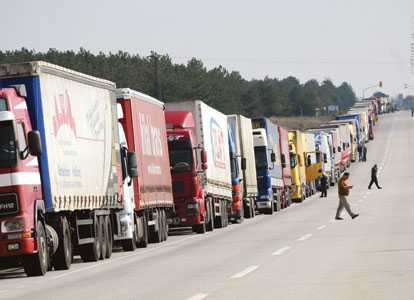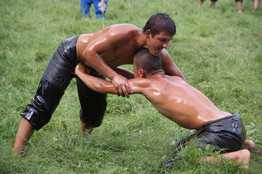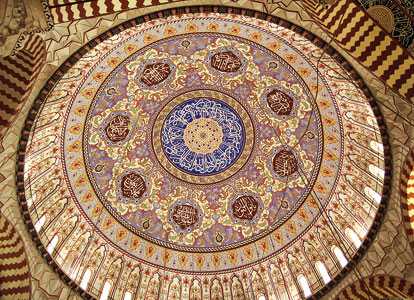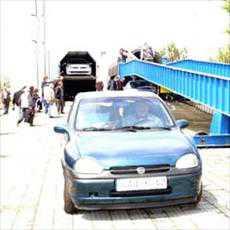Edirne, Turkish attraction
- By Jumana Al Tamimi, Associate Editor
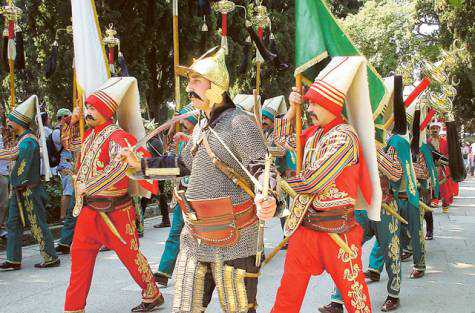
- Image Credit: Jumana Al Tamimi/Gulf News
- Sami Al Jallaf, Director of Commercial Affairs at Ajman Chamber of Commerce and Industry (second from left) during his talks with Turkish officials in Edirne. Al Janahi is the on the right.
Dubai: Most tourists seek sun and sand but in the western Turkish city of Edirne they come to see a mosque and wrestling.
Edirne, which was for nearly 100 years the capital of the Ottoman Empire, prides itself of its monuments and rich history – two aspects the city’s mayor is leveraging to market Edirne to the world.
“In 2011, approximately two million tourists visited Edirne and this year we are hoping to receive 3 million,” said Hamdi Sedefçi, mayor of Edirne.
The city is looking to build on its reputation as the host of an annual wrestling match called Kirkpinar, considered one of the oldest continuously practiced sport in the region, and a 16th century mosque. The city’s officials hope to attract foreign investment to revamp its hospitality and services sectors, and dress its promenade with shopping and recreation centres.
Article continues below
Up to 33 million tourists are expected to visit Turkey this year, according to Turkish culture and tourism minister Ertuğrul Günay. Revenues from travel and tourism contributed TL55.1 billion in 2011, or 4.3 per cent of GDP, according to London-based World Travel and Tourism Council. The figures are expected to increase by 1.7 per cent in 2012 and by 2.9 per cent a year from 2012 to 2022 to TL74.4bn, the council said.
As per Ankara’s Culture and Tourism Ministry 2007 forecast, Tourism Strategy of Turkey-2023 is expected to generate US$ 86 million in international tourism receipt from 63 million travellers by 2023.
Edirne, located 225 kilometres from Istanbul, is hoping for a piece of the pie.
The tourist footfall to the town increased after Selimiye Mosque and its complex was added to the UNESCO’s world heritage list last year.
Kirkpinar, a Turkish sport that can be traced back to the 14th century, has its roots in Edirne. It was added to the List of the Intangible Cultural Heritage of Humanity of the UNESCO as well.
“Edirne is rich in cultural and heritage tourism, and I think this is the reason why tourists come,” Sedefçi told Gulf News through an interpreter.
This year, Edirne started receiving tourists from as far as Japan, he said.
Apart from its Ottoman memorials, the city, which is located near the Bulgarian and Greek borders, also has Byzantine ruins and ancient churches, and houses a synagogue and some Baha’ houses.
The Selimiye Mosque, which was commissioned by Sultan Selim II, was built by famous Turkish architect Mimar Sinan in the 16th century. The structure is considered Sinan’s masterpiece. It is also described as one of the best achievements of Islamic architecture.
The annual three-day Kirkpinar tournament attracts thousands of people. Some of them come from the neighbouring countries such as Bulgaria and Greece as well as other parts of the Turkey.
The UNESCO’s citation said the wrestling festival “is strongly rooted in the practitioner community as a symbol of identity … and [reinforces] members’ bonds with tradition and custom.”
In one of the traditions of Kirkpinar, the winner has to walk barefoot some 1.5 km to a Turkish bath in the city for free treatment. The winner for three consecutive years gets to keep a golden belt he wins.
This year’s winner, who comes from a well-known wrestling family from Antalya, hopes to keep the belt in memory of his father, a wrestler who died of brain illness, according to some Turkish spectators from the city.
However, most of the tourists here stay hardly for a day.
Out of the two million visitors, “261,487 tourists stayed overnight at its hotels,” said Metin Kilic the Turkish foreign ministry’s representative in Edirne said.
“Greek, Bulgarian and other Europeans as well as Far Eastern nationals dominate the visitors,” he said. The city attracts tourists during the period between April and mid July.
The general short-term stay of tourists explains the spread of great restaurants in the city, including on the sides of its rivers, offering delicious dishes from the Turkish cuisine. But on the other hand, there are just 20 hotels, the vast majority of them are boutique hotels, or small hotels – and the highest rank of these hotels are three stars. The city is open to Turkish and foreign investments, mostly in hospitality and service sectors, Sedefçi said.
Foreign investors, however, first need to identify Turkish partners and establish a company.
“Edirne is a diamond that has not been shaped yet; we want it to be shaped, and we need sculptures,” he said.
The mayor of the city for nearly 19 years, Sedefçi has his plans.
One of them is to build a tower in Turkey, overlooking both Bulgaria and Greece. The 100 million Euro or US$ 121 million structure would be a symbol for “friendship like Selimiye mosque is a symbol to the Ottoman Empire”, he said.
Other projects include shopping centers and recreation areas along the sides of the rivers in the city, where the bridges from the Ottoman era still stand as symbols of the rich history of the city.
On the impact of development on the green and clean environment of the city, Sedefçi said he also cares about environment and will never allow any damage to it.
“I love nature very much and I care about it,” he said. “Once some from the public called me Mr. Flower, because I love nature and love flower.”
“In Turkey, there are 7 square meters of green per person; in Edirne, the green area is 20 square meters per person,” he said, adding he won’t allow chemical factories to be built in the city.
The city, which prides itself on its safety and low crime rates, is expected to be benefit from a fast train to Istanbul by 2018. Today, buses take nearly 2 and half hours to connect Edirne with the busiest Turkish cities.
“Turkey is a big country; it has 581 cities,” said Gokhan Sozer, who is the local governor of Edirne. “Each city has different characteristics, and we call this richness, not differences,” he told Gulf News.
“The importance of Edirne is both cultural and in its monuments.”

